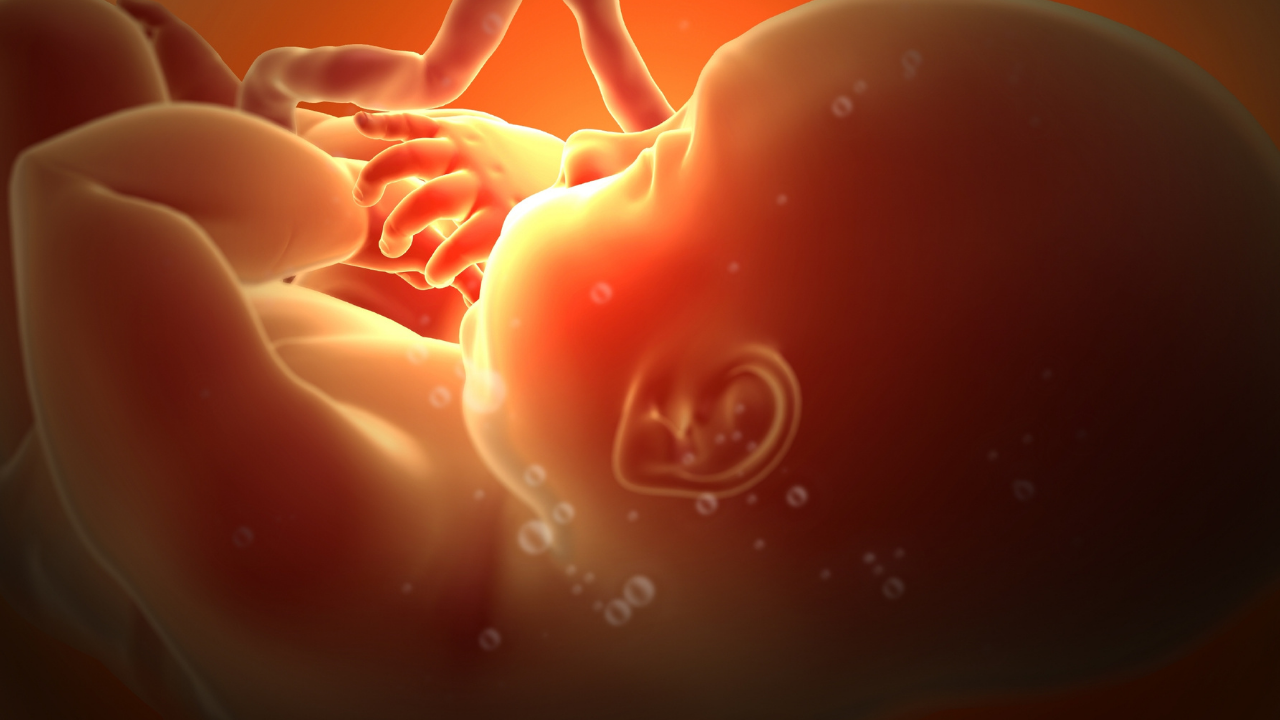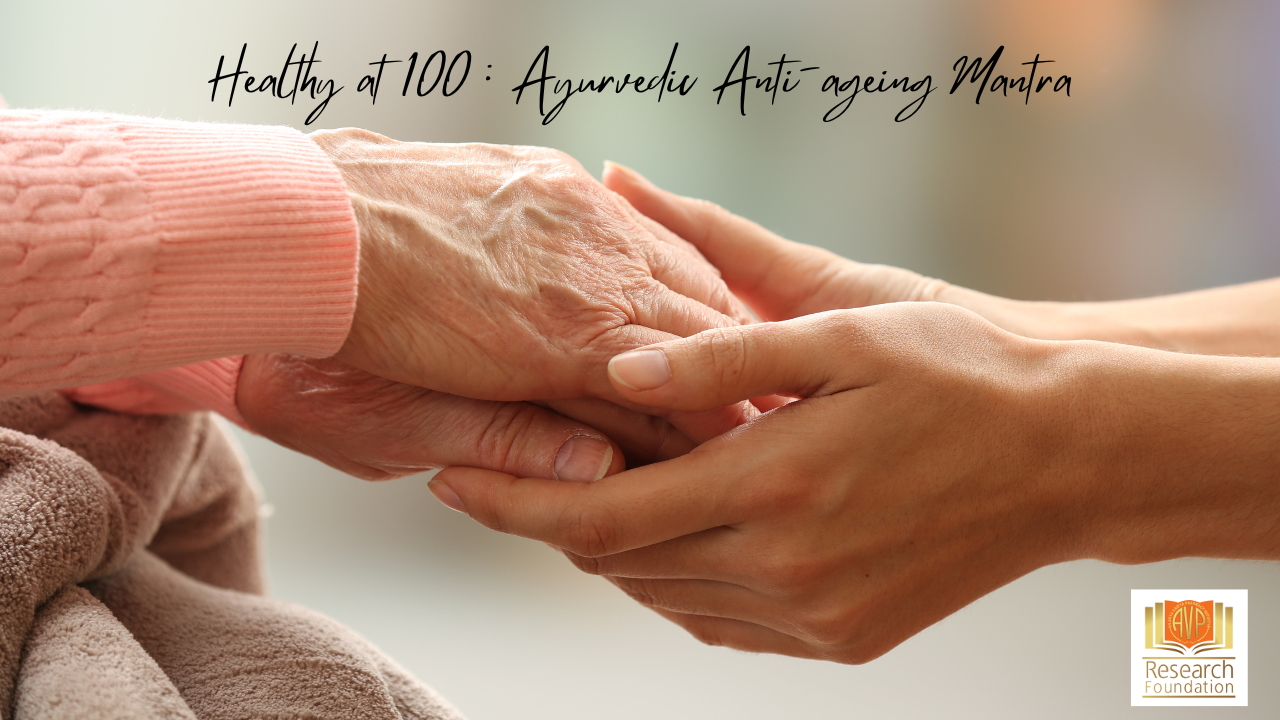In the Kaliyug, the motto is "healthy at 100," which comes from the Vedas.
The Vedic quest for knowledge of life and its spiritual element was built on the principle of longevity.
Quotes from the Atharva Veda, which is where Ayurveda, the science of life, comes from states.
एह्यश्मानमातिष्ठाश्माभवतुतेतनु : |
कृण्वन्तुविश्वेदेवाआयुष्टेशरद : शतम ||AV. 2.13.4||
O child, please sit firmly on this rock so that your skin will become as stony as the rock itself. May the gods grant you a 100-year lifespan.
Aṣṭāṅgasaṅgraha written by Vāgbhata (वाग्भट) is one of the most influential classical writers of Ayurveda in 5th century CE. States in the maiden verse of the book :
आयु:कामायमानेनधर्मार्थसुखसाधनम्।आयुर्वेदोपदेशेषुविधेय: परमादर:
To achieve Dharma, Artha, Kama, and Moksha, which signifies true bliss and contentment (sukha), one should aim for longevity and physical well-being.
What does Charaka's definition of Ayurveda mean?
hitAhitaM sukhaM duHkhamAyustasya hitAhitam|
mAnaM ca tacca yatroktamAyurvedaH sa ucyate||41||
Charka says that Ayurveda is a normative science that explains what routines and behaviours are beneficial or detrimental for achieving physiological homeostasis, psychospiritual well-being, or social gratification. By following the Precepts, one can delay ageing and live longer.
Geriatrics is an integral part of specialty care in Ayurvedic scriptures.
Suśrutasaṃhitā which was written between 1200 BCE and 600 BCE, discusses about eight specialties in Ayurveda. He describes about Jara chikitsa, or care for the elderly, as core specialties.
Rasayana is the science of slowing down ageing. Herbs and physical therapies are used to treat not only physical and mental symptoms, butalso epigenetically modify programmed cell death and cellular intelligence to delay the onset of ageing.
What is ideal criterion to understand anti ageing therapy outcome ?
Rasayana therapy is intended, by definition, to boost and strengthen the systems by promoting their bimolecular and cellular functions. It helps improve the higher functions of the brain and mind, like cognition, memory, speech, intelligence, etc. It thus acts as a preventive therapy for ageing and age-related disorders, increasing the longevity of an individual.
(1: C.Ci.1; 2: S.Ci.27).
Ayurveda's conception of optimal health is consistent with the WHO's Alma Ata definition of 1977 definition of health.
Ayurveda defines true health based on optimal function of living body, by regulation of Complex adaptive systems of three patho-physiological attributes known as vata, pitta, and kapha, efficient metabolism and regulated excretory functions based on structural and functional integrity of tissues, organs, etc., as well as efficient sensory motor coordination with psycho spiritual wellbeing.
Is ageing reversible?
It is too difficult to change the progression of ageing at the organismal level; however, ‘relative rejuvenation’ at the cellular or tissue level is possible and slowing down of ageing can be achieved by using bioactive ingredients from some plants or some technological features.
Approximately ~39% of the world adult population is overweight due to unrestricted access to food and sedentary lifestyle, increasing the incidence of cardiovascular disease, obesity, diabetes, and stroke.
Dietary interventions, including regulation of the amount and timing of food intake and length of fasting periods, have become attractive methods for mitigating age-related physical decline and chronic diseases
Mis-alignment of circadian rhythms makes the individual prone to ageing, sleep disorders, cancer, diabetes, and neuro-degenerative diseases.
What accelerates ageing ?
Disregulated inflammation, alteration of epigenetic modifications, and metabolic imbalance converge to cell senescence and ageing.
Approaches to alter local and systemic metabolism. Six aspects, including environmental stimuli, sleep modulation, exercise, intestinal microbes, diet, and drug interventions, may reprogram the metabolism thereby benefiting to healthy ageing
Why Ayurveda relevant in realm of personalised medicine for Anti Ageing?
Systems or holistic approaches to complexity, genome projects, omics data, advances in experiments, algorithmic designs and mathematic formulation in bioinformaticsfacilitating applications and implementation of network models gave birth to P4 (preventive, predictive, personalized, and participatory) medicine .
The concepts and practice of Ayurveda resonate with the aims, observations and the promise of con- temporary P4 medicine; it is predictive, preventive, personalized and participatory medicine
The firstconceptualisation of personalisation in medicine is indeed described in the “prakriti” concept of Ayurveda 4000years BC, where much importance was given to the holistic connection between the body, the mind, and the spirit.
Personalised solution from Ayurveda ?
Hetu (the causes of ageing), Linga (the symptoms of ageing based on epiphenotypes), and Aushadha (interventions based on diet, lifestyle, herbs, and psychospiritual counselling) make up a functional network medicine framework for both healthy and unhealthy ageing. By using the ideas of spatio-temporal dynamics of Prakrithi (Innate epiphenotype) , Vikriti (pathological epiphenotype) , Desha (Geography) , Kala(Climatic zone), Satmya(Ethnic, Lifestyle and dietetic adapatability),etc. uses what we know about physiological networks to make anti-aging protocols that are both predictive and tailored to each person's needs.
It's true that you can programme your own ageing before you're born, so why not be born to live a long, healthy life?
Similar to hunger, thirst, and sleep, ageing falls under the category of Swabhavaja vyadhi, or intrinsic diseases.
Charaka explains in the theory of natural destructions (Swabhavoparamavada) that one can identify various causes for how different life forms evolve, but once it manifests, degeneration or decay begins spontaneously and simultaneously with no apparent cause, since death after birth is a state of natural flow.
Life extension can be programmed into your Prakriti.
By programming a superior Kapha Epigenotype, where Ayurvedic texts promise the longest life span with the lowest morbidity and the highest quality of life. This is possible by adhering to the precepts of Panchakarma-based preconception and Ayurveda-based nutrition and herbal therapy during pregnancy.
Longevity protocols and Ayurvedic epigenetic factors for ageing and senescence.
The ageing process is influenced by the balance of Shareera (physical), Indriya (emotional), Satwa (psychological), Agni (metabolism), and Bala/Ojas (immunity).Ageing is also influenced by Parinama (molecular and cellular metamorphosis), Sharira vriddhikara bhavas (genotypic and phenotypic attributes), and Garbhahinivrittikara bhava (pregnancy-induced foetal development).
Ahara (diet) and Vihara (lifestyle)are two other significant factors that influence ageing. Unwholesome and non nutritious food (GramyaAhara) coupled with an unhealthy lifestyle vitiates one or all three Doshas, resulting in pathological changes and a shorter lifespan.
The Ayurvedic circadian routine gives numerous instructions for the operation of the body clock in terms of time and season-based routines known as day routines (dinacharya), night routines (ratricharya), and seasonal routines (ritucharya). These are rituals for longevity.
Sleep ( Nidra )According to Ayurveda, sleep is just as crucial to maintaining a high-quality healthspan as one's nutrition.
Panchakarma Ayurvedic panchakarma therapies, which include periodic detoxification, purification, and rejuvenation treatments, are highly recommended because they strengthen and nourish the body's deeper tissues (Dhatus) and mellow age-related health issues.
Charaka's anti-aging prescription, which includes herbs that target a network of pharmacological actions. Predominately these include the following 11 herbs listed below:
अम्रुताऽभयाधात्रीमुक्ताश्वेताजीवन्त्यततरसामण्दूकपर्णीस्थिरापुनननवाइततदशेमातनवयःथिापनातनभवस्ि Ca.Su. 4/18 [1]
Amruta (Tinospora cordifolia Miers), Abhaya (Terminalia chebula), Dhatri (Emblica Officinalis Gaertn.), Mukta (Pearl), Shveta (white variety of Clitoria ternatea Linn.), Jivanti (Leptadenia reticulate), Atirasa (Asparagus racemosus Willd.), Mandukaparni (Centella asiatica Urban.), Sthira (Desmodium gangeticum), and Punarnava (Boerhavia diffusa Linn.) are included in Vayahsthapana Dashakaya.( Herbs for anti-aging )
Author
Director and CSO , AVP Research Foundation ,
Coimbatore , Tamil Nadu
References
Xue, F., Li, X., Qin, L., Liu, X., Li, C., & Adhikari, B. (2021). Anti-aging properties of phytoconstituents and phyto-nanoemulsions and their application in managing aging-related diseases.Advanced Drug Delivery Reviews, 176, 113886.
Acosta-Rodríguez, V.A., Rijo-Ferreira, F., Green, C.B.et al.Importance of circadian timing for aging and longevity.Nat Commun12, 2862 (2021). https://doi.org/10.1038/s41467-021-22922-6
Tabibzadeh, S. (2021). CircadiOmic medicine and aging.Ageing Research Reviews, 71, 101424.
Zhu, X., Chen, Z., Shen, W., Huang, G., Sedivy, J. M., Wang, H., & Ju, Z. (2021). Inflammation, epigenetics, and metabolism converge to cell senescence and ageing: the regulation and intervention.Signal Transduction and Targeted Therapy, 6(1), 1-29.
Zhang, Wei, Jeremy Chien, Jeongsik Yong, and Rui Kuang. 2017. Network-based machine learning and graph theory algorithms for precision oncology. Nature Partner Journals Precision Oncology. https://doi.org/10.1038/s41698-017-0029-7.
Auffray, Charles, Dominique Charron, and Leroy Hood. 2010. Pre-dictive, preventive, personalized and participatory medicine: back to the future. Genome Medicine 2 (57): 1–3. https://doi. org/10.1186/gm178.
Cesario, A., Lohmeyer, F. M., D’Oria, M., Manto, A., & Scambia, G. (2021). The personalized medicine discourse: archaeology and genealogy.Medicine, Health Care and Philosophy, 24(2), 247-253.
Datta HS, Mitra SK, Paramesh R, Patwardhan B. Theories and management of aging: modern and ayurveda perspectives. Evid Based Complement Alternat Med. 2011;2011:528527. doi: 10.1093/ecam/nep005. Epub 2011 Jun 8. PMID: 19233879; PMCID: PMC3136561.
Peterson, C., Lucas, J., John-Williams, L.et al.Identification of Altered Metabolomic Profiles Following a Panchakarma-based Ayurvedic Intervention in Healthy Subjects: The Self-Directed Biological Transformation Initiative (SBTI).Sci Rep6, 32609 (2016). https://doi.org/10.1038/srep32609










.png)


.png)
.png)
.png)
.png)
.png)
